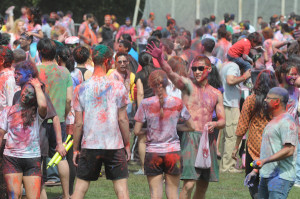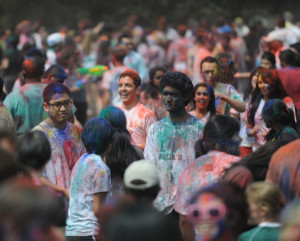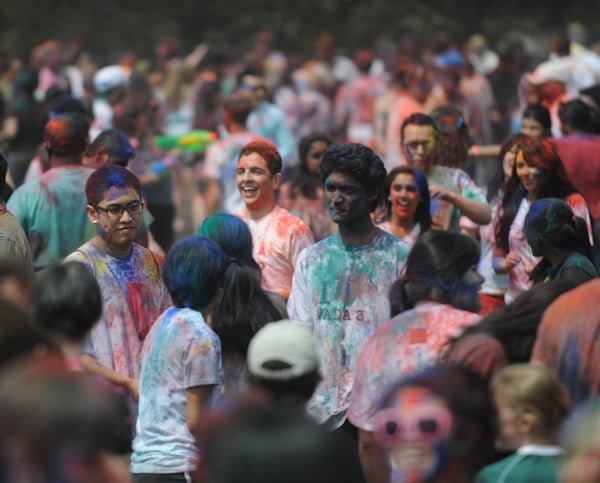Having a fistful of magenta powder thrown at you upon entering a festival might seem threatening at first. But at Holi, a Hindu celebration heralding the coming of spring and a new harvest, it is actually a way of saying “Happy Holi!”
This past weekend, on Saturday and Sunday from 11 a.m. to 3 p.m., Stanford’s Asha for Education put on its annual Holi celebration at Sand Hill Fields.
The celebration comes from an Indian legend in which the son of a tyrannical king survives a fire through the power of his devotion to the god Vishnu. Typically celebrated on March 8, Asha postponed the celebration festival by a month in hopes of warmer weather.
This weekend, the 5,500 pounds of blue, red, yellow, green and orange powder at Holi represented the ashes from this myth. The tradition of throwing colors is also attributed to the blossoming colors of spring, from a past in which India was predominantly an agrarian society following the seasonal crop table.
“Holi is now seen as a Hindu cultural tradition that transcends religious boundaries,” said Asha projects coordinator Arvind Krishna, a fifth year Ph.D. candidate.

Not only does Holi transcend religious boundaries, but it also focuses on breaching class and social structures.
“Holi is an event open to people from different races, religions and classes who are able to come together and let go of social inhibitions,” said Amruta Hardikar, Holi media coordinator.
The experience of attendees echoed these remarks.
“It was my first time attending Holi, and I was surprised by how freely old and young people lost themselves in the powder,” said Rebekah Oragwu ’15.
Stanford’s Asha chapter, founded in 1992, started hosting Holi in 1999. Asha, meaning ‘hope,’ is a non-profit organization founded at the University of California, Berkeley in 1991. Since then, it has expanded to include more than 50 chapters throughout the United States, Europe and India.

Correspondingly, Asha’s Holi at Sand Hill Fields has grown from a small event with around 200 participating students to a widely anticipated event with more than 7,500 attendees. As the biggest Holi party in the Bay Area, Stanford Holi attracts a mix of students and families from miles around.
Along with water and color fights, participants can enjoy Bollywood and pop music from DJ Tanveer, performances by dance groups such as Dance Identity and Stanford Dil Se, and fresh Indian food.
Asha for Education’s mission is to fundraise for the education of underprivileged children in India.
“Each year, we feature a particular project to put a face on the kind of work we do,” Krishna said.
Specifically, Asha has funded the creation of eco-friendly schools in rural India in cooperation with Steve Blank, a lecturer in the Department of Management Science and Engineering (MS&E). The project seeks to combine education, energy and economics to improve the quality of government schools. Using energy-efficient building designs that run on low-cost solar power systems, the project leaders plan to educate villagers on energy-efficient agricultural practices.
“This is done to help the economy and to help villagers by giving them access to technical knowledge,” Krishna said.
Asha has also raised funds for a school for handicapped children in India. This school focuses on addressing problems that physically handicapped children face on a daily basis by offering features such as accessible ramps and concentrated teacher attention. According to Krishna, even 100 dollars can make a huge difference in the life of a blind student through the purchase of a text-to-speech converter.
By addressing problems that are endemic to certain regions in India, both rural and urban, Asha is able to provide opportunities to children who do not have educational options or privileges.

“At the end of the day, my efforts make it possible for Asha to put a few thousand kids in school,” Hardikar said. “I think in the long run this will probably lead to the emergence of a better India.”
In addition to providing financial support, Asha also aids schools by putting them in touch with officials to inform them of the progress of their government funds, a right guaranteed by India’s Right to Information Act.
“Raising money, of course, is one thing that we do, but our goal is not just to raise money but also help [disadvantaged students] in any way we can,” Krishna said.
While Holi at Stanford allows students to let loose by tossing colored powder at friends and strangers alike, dancing freely to music blasting over Sand Hill Fields, it also presents an opportunity to help students thousands of miles away receive a good education.

“I felt carefree and able to let go of inhibitions and just enjoy spring while having fun with my friends,” said Guadalupe Ramirez ’15. “You could throw powder at people you didn’t even know, like the water fight my friends and I had with little kids. It was also nice knowing it went to a good cause.”
